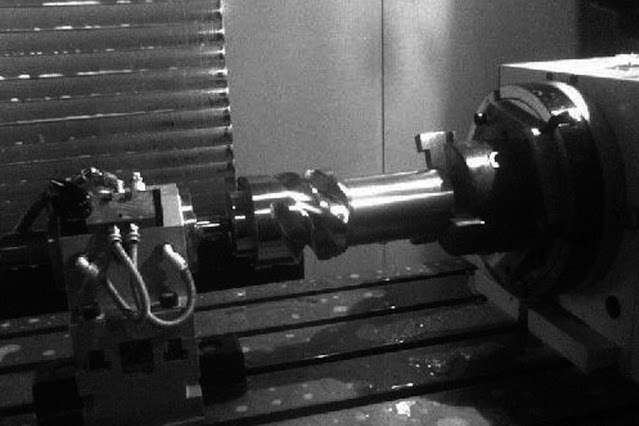In CAM software programming, the tool path (tool path) and parameter selection of CNC machine tools directly affect the processing efficiency and quality of small CNC milling machines.
How to ensure higher processing efficiency and processing quality is a problem that must be paid attention to in the process of CNC machining. Mastercam X7 provides a variety of milling tool paths. The following describes the characteristics of the tool path of a small CNC milling machine.1. Two-dimensional processing on a small CNC milling machine
- (1) Contour machining (contour) The tool moves along the selected curve, which is used for contour rough machining and finishing, simple and practical. Usually use flat-bottomed knife, round nose knife, oblique knife processing. Shape milling can feed in and lower the tool outside the material to avoid the corners of the curve. Such as choosing 3D curve shape milling.
- (2) Pocket machining (pocket) selects a closed curve to determine the machining range. It is often used for rough machining of groove features, and can be used for plane finishing when the machining depth is limited. Slotting is performed on the blank and the spiral or oblique downward knife is used when the knife is lowered. The knife is often used to go back and forth (zigzag).
- (3) Face processing (face) is used for surface roughing and finishing. The same purpose can be achieved by grooving.
- (4) Drilling (dirll) has multiple processing methods such as drilling, tapping and boring, and the processing position is determined by points.
2. Surface rough machining of small CNC milling machine
Surface pocket processing (pocket) removes all materials between the curved surface and the Chinese-style range in layers, and the surface of the finished workpiece is terraced. The tool path calculation time is short, the tool cutting load is uniform, and the processing efficiency is high. The most common way to use the knife is to add a knife. Compared with other rough tool path efficiency, it is often used as the first step.
Contour tool is processed along the contour curve of the curved surface. After the commonly used flat-bottom tool is processed, the surface of the workpiece is terraced. The effect is not good when the surface is flat. This option is available in surface roughing and finishing types.
- Parallel processing (parallel) layered parallel cutting processing, the surface of the workpiece after processing is parallel striped. The tool path calculation time is long, the number of tool lifts is large, and the roughing efficiency is not high. It is often used for the finishing of symmetrical parts.
- Radial machining (radial) The designated point of the tool is the radial center, and the cutting is radiated. The tool path of the workpiece surface after processing is radial on the workpiece surface. The tool path is dense in the radial center of the workpiece, the tool path overlaps more, the tool path spacing around the workpiece is large, the number of tool lifts is large, the processing efficiency is low, and it is rarely used.
- Projection processing (project) will project the existing tool path data onto the curved surface for processing.
- Curved surface flowline machining (flowline) tool is processed according to the horizontal or vertical structure line direction of the curved surface.
- Rough machining restmill processing (restmill) according to the structure of the machined tool path data for further processing to remove the rest mill, the calculation time is long.
- Plug-in processing (plunge) type drilling method processing.
3. Surface finishing of small CNC milling machine
- Parallel machining (parallel): Similar to rough machining, there is no depth direction control. For step-by-step small curved surfaces, the processing effect is better, and the processing angle needs to be controlled when there is an inclined surface. It is the preferred tool path in the finishing stage.
- Contour: Similar to roughing, the roughing stage is always the second tool path, and a small diameter tool is used to remove residual material. Finishing is used for light knife and clear corner of side wall contour.
- Radial machining (radial): The tool moves and processes in the form of incidence with the specified point as the radial center.
- Projection processing (project): Project the existing tool path data to the surface for processing.
- Curved surface flowline processing (flowline): The tool performs processing according to the direction of the horizontal or vertical structure line constituting the curved surface.
- Parallel steep slope processing (dar.steep): A supplementary solution for the poor effect of parallel processing of steep slopes. It can control the parallel processing angle and cooperate with other tool paths to solve such problems.
- Shallow processing (shallow): A supplementary solution for the low-slope surface of the contour method with low slope.
- Intersecting line angle clearing processing (pencil): processing the intersection position of the curved surfaces to remove the residual material.
- Residual material removal processing (leftover): Calculate the tool path of the rough machining, and use a small diameter tool to remove the residual material left during finishing, which takes a long time to calculate.
- Scallop: The generated tool path is equidistant around the surface to be machined. The tool path is more uniform, the calculation time is long, and the surface is complex, pay attention to the direction of the cutter to prevent interference between the tool and the unprocessed area.




